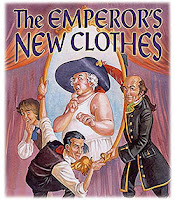Case o' The Week: Paris is Worth a Mass, Cherer

The Guidelines have no clothes -- and Gall and Kimbrough give experienced federal jurists just the platform they need to bluntly point this out. The latest broadside fired at the guideline edifice comes in a great dissent by Judge Noonan in United States v. Cherer, __ F.3d __, 2008 WL 200553 (9th Cir. Jan. 25, 2008), decision available here. While the Cherer opinion is a mediocre decision that dodges meaningful "reasonableness" review, Judge Noonan's great dissent foreshadows debates that will occupy the Ninth in '08.
Players: Spot-on dissent by Judge John Noonan.
Facts: Mr. Paris Cherer had a sexually-explicit dialogue with an FBI agent on AOL. 2008 WL 200553, *1. In several e-mails, the agent represented that she was fourteen, sent Cherer a picture of a fourteen-year old girl, and talked about her parents’ supervision. Id. at *3. Cherer traveled to meet “Susie”, was arrested, and was convicted at trial of 18 USC § 2422(b), attempting to entice a minor to have sex. Id. at *1.
At trial, the district court judge: 1. refused to give the defendant’s mens rea instruction, 2. let in FRE 404(b) evidence on Cherer’s prior state conviction for “lewdness with a child under fourteen,” and previous complaints made to AOL about his sexual dialogue from his screen name.
At sentencing, the court imposed a guideline sentence of 293 months - over 24 years. Id. at *1.
Issue(s): 1. Mens Rea/ Instructions: “On appeal, Cherer argues that the court committed prejudicial error by refusing to deliver his proposed [mens rea] instruction . . . .” Id. at *
2. FRE 404(b): “Cherer argues that Rule 404 or 403 should have barred evidence of this prior conviction and the AOL complaints.” Id. at *5.
3. Sentencing: “Since the district court committed no procedural error, the only question remaining is whether the sentence was reasonable - i.e., whether the District Judge abused his discretion in determining that the § 3553(a) factors supported a sentence at the top of the Guideline range.” Id. (internal quotations and citation omitted).
Held: 1. Mens Rea/ Instructions: “[T]he instructions did not explain that the jury was required to find that Cherer believed that the target, ‘Susie,’ was a minor. In other words, neither appropriately connected the requisite state of mind – knowledge – with the statute’s object – a minor victim.” Id. at *3. [But, harmless error.]
2. FRE 404(b): “The district court properly exercised its discretion to admit both pieces of evidence.”
3. Sentencing: “[E]ven without presuming that a within-Guideline sentence is reasonable, we cannot say that Cherer’s within-Guidelines sentence is unreasonable.” Id. at *8.
Of Note: Last week we touted Sixth Circuit Judge Merritt’s broadside on “guidelinitus;” this week brings us a remarkable dissent by our own Judge Noonan (left). Id. at *9 (Noonan, J., dissenting). He begins with a clean list that summarizes the playing field after Gall and Kimbrough: the Guidelines are only advisory, a district court can not presume they are reasonable, sentencing must be individualized, and comparison of various types of sentences may be taken into account where the reas
 onableness of the sentence is at issue. Id. at *9-*10.
onableness of the sentence is at issue. Id. at *9-*10.Here, Cherer got straight probation in the prior Nevada case for actual sexual contact with a minor – then nearly twenty-five years for attempted sex with (what turned out to be) an adult FBI agent! Judge Noonan compares another home-invasion rape case that earned the defendant seven years – while Cherer gets a quarter-century for his “clumsy efforts to obtain forbidden sex?” Id. at *11. "A majority of judges appear to agree that Cherer's sentence was 'unduly harsh.' But the court finds the sentence not 'unreasonable.' That is such a fine distinction as not to be readily comprehensible." Id. at *12.
Emperor USSG has no clothes: Gall and Kimbrough give license to experienced jurists like Merritt and Noonan to expose the realities of Guideline injustice.
How to Use: There’s little admirable in the Cherer majority decision, but don’t let the outcome overshadow an important defense victory on the mens rea requirements in Section 2422 cases. The Court concedes that “when a defendant, like Cherer, has targeted an adult decoy rather than an actual minor, the Ninth Circuit requires that the defendant have believed the target was a minor.” Id. at *2. This is an important affirmation of a viable defense – particularly because many districts are seeing huge upswings in these types of prosecutions.
For Further Reading: Sentencing discrepancies between state and federal prosecutions are fair game for § 3553(a) variances. So are inane guidelines that generate wildly disparate sentences for attempt crimes. Judge Noonan’s dissent amplifies arguments that we’ve made in our upcoming Champion article on Gall and Kimbrough – an article that will be widely available at www.fd.org within a week or two.
Steven Kalar, Senior Litigator N.D. Cal. FPD. Website at www.ndcalfpd.org
.
Labels: 18 USC 2422, Appellate Review, Gall, McKeown, Noonan, Sentencing

0 Comments:
Post a Comment
<< Home